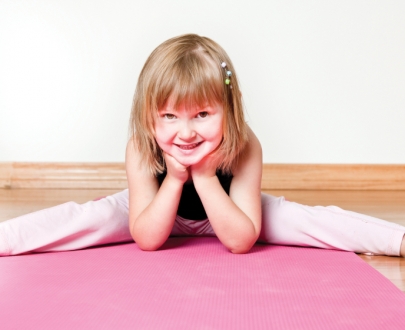
Supporting a district-wide effort to integrate self-regulation practices into local schools, Heather Kulbida, an Education Assistant at Bowen Island Community School designed a classroom activity[1] to introduce children to simple yoga practices.
Lesson Plan: Body Breathing
Background & Learning Outcomes:
The activity introduces students to the mindful practice of yoga which cultivates self-regulation by focusing on controlled movements combined with breathing awareness. Some studies suggest a positive connection between mindful practice (including yoga and breathing) and children's capacity to cope with stress[2], manage emotions[3] and improve concentration[4].
Materials:
- quiet space
- yoga mat for each student set up in a row (before students arrive)
Teaching and Learning Activities:
1. Ask students to leave shoes and socks outside of the practice room and enter the space in silence. Practice begins when students enter the room.
2. Begin in a seated posture on mats.
-
With legs crossed, reach the crown of the head up to lengthen the spine while dropping the shoulders down and back.
-
For students who have difficulty finding this pose, place your hand on the mid-low back to encourage the spine to lengthen.
3. Invite students to close their eyes so that they can be more aware of their place in the yoga space noticing the stillness of their body, keeping the face and jaw relaxed.
4. Invite students to place their hands on their belly and bring their attention to the feel of their hands on their belly.
-
Ask students to notice that their hands are moving because of the inhale and exhale breath. Observe the physical sensations in that place – are their hands warm? do their hands feel heavy on their belly?
-
Do this for up to 5 breath cycles.
5. Invite students to open their eyes and to place their hands to their knees and focus on their moving belly with just their awareness.
6. Ask the students to stand up on their mats, describe this position as Mountain Pose and continue to pay attention to their breath – they will notice an expansion of their chest or the rise and fall of their shoulders.
7. Begin moving into Crescent Moon Pose.
-
Inhale: cue the students to open their arms wide like a hug, sweeping their arms towards the ceiling, hands come together at the top.
-
Exhale: pause.
-
Inhale: extend palms towards the ceiling (sky), dropping shoulders away from the ears.
-
Exhale: bend at the waist to the right side of the body (a side bend). Remind students that arms, head, shoulders, hips, and feet are all in one plane with feet rooted to the ground.
-
Inhale: come back to center – arms still extended skyward.
-
Exhale: bend at the waist to the left side of the body.
-
Repeat steps 10 – 14 for a total of 3-4 times for each side (ensure equal treatment to both sides of the body and move into positions smoothly guided by their belly breathing).
8. Return to Mountain pose to finish practice.
Adaptations:
- Embed yoga elements into the classroom context during other instructional times such as prior to taking a test or settling into work after recess or lunch.
This lesson plan is adapted from School District 45 - West Vancouver, British Columbia who are part of the Canadian Self-Regulation Initiative.
Mindful practices for stress reduction.
In a study of fifth grade students, yoga technique training resulted in a reduction in feelings of helplessness and aggression. The authors also suggest that the participants transferred the learned breathing techniques and self-instructions to situations beyond school, in order to relax after the lessons, to improve well-being and to control negative feelings.
A School-Based Mindfulness Intervention For Urban Youth: Exploring Moderators of Intervention Effects.
In a randomized control trial, a 12-week, secular, yoga-inspired mindfulness program was introduced to 4th and 5th graders. Emotion-regulatory outcomes such as depressive symptoms, postive and negative emotions and stress were measured.
Findings highlight that receiving the intervention reduced stress in both male and females. Of significance, youth that reported low or medium levels of baseline depressive symptoms benefited the most.
Yoga as an Intervention for Children with Attention Problems.
In this study, children in grade three participated in an intervention that consisted of 30 minutes of yoga, twice a week for 3 weeks. Results align with other published studies that show improved scores on static motor performance tasks and concentration as well as a reduction in anxiety, heart rate and stress symptoms.
